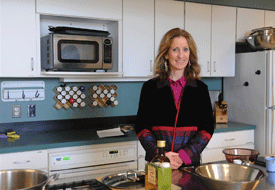 |
|
|
Dietitian and nutrition researcher Barbara Olendzki, RD, MPH, pictured here in the teaching kitchen at UMMS, is lead author of a survey that found unexpected disparities in access to healthy foods in Central Massachusetts. |
A survey of food stores across Central Massachusetts has found that many communities in the region lack easy access to affordable and nutritious food, particularly for those without cars, according to research from UMass Medical School and the Massachusetts Department of Public Health.
The findings point to the need for public policies to ensure all Worcester County residents have convenient access to healthy foods.
“It’s easy to get unhealthy food everywhere you go, but finding healthy food is not so easy,” said dietitian Barbara Olendzki, RD, MPH, assistant professor of medicine, director of UMass Medical School’s Center for Applied Nutrition and co-author of “Disparities in access to healthy and unhealthy foods in Central Massachusetts: Implications for public health policy.” The survey was published online March 10by the Journal of the American College of Nutrition.
In this food availability study, researchers went inside stores to see what they have for sale, instead of just noting if there is a store in a particular location. The investigators repeatedly visited 106 food stores in 68 communities over a three-year period, and recorded which healthy and unhealthy major food items were sold in each store.
“By linking the store field survey results with sociodemographic statistics from the U.S. Census and Massachusetts transportation data, we uncovered significant geographic and income disparities in access to healthy foods in Central Massachusetts,” said Wenjun Li, PhD, associate professor of medicine, director of the Health Statistics and Geography Lab in the Division of Preventive and Behavioral Medicine at UMMS and principal investigator on the study.
Twenty-seven communities had no food stores at all, and five communities had only one or a few stores with a very limited availability of healthy foods; these 32 communities are home to nearly a quarter of Worcester County’s population. Unexpectedly, many communities that lack food stores were in the top income levels, indicating that even affluent suburban communities can be food deserts.
Nearly half of the surveyed stores had what researchers defined as inadequate availability of healthy food. Due to the widespread availability of unhealthy foods, even communities where healthy foods are available offer consumers as many unhealthy options, which may influence their food buying decisions.
Supermarket chains offered the widest selection of healthy foods, but the level of unhealthy foods in the same stores was proportionately high, with choices in different stores of the same chain varying significantly between locations. And small independent stores and stores in rural locales may stay afloat by diversifying their inventories with unhealthy foods.
“Over the period of time that we have been returning to food stores in Central Massachusetts, we’ve seen a number of the independent stores in small towns go out of business. What this means is that people who rely on public transportation, or only drive locally, or